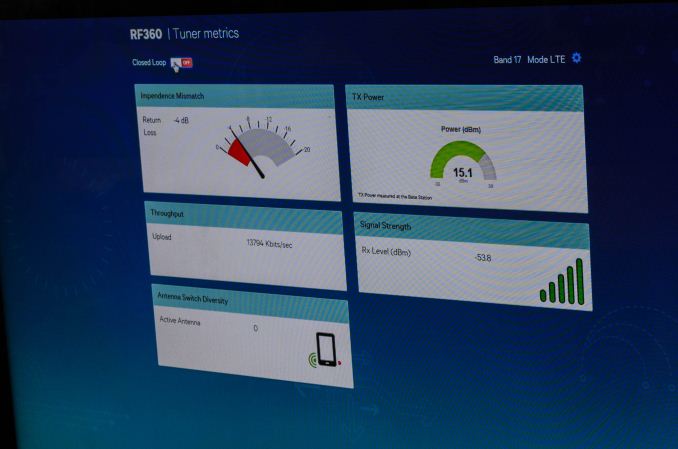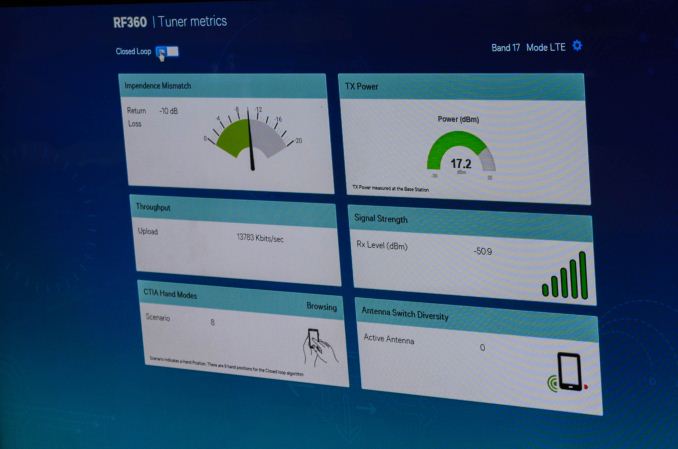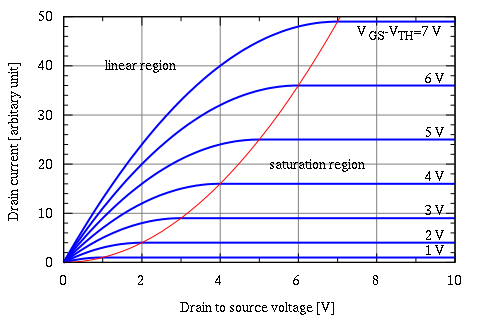Understanding Qualcomm's Snapdragon 810: Performance Preview
by Joshua Ho & Andrei Frumusanu on February 12, 2015 9:00 AM EST- Posted in
- SoCs
- Qualcomm
- Mobile
- Gobi
- Snapdragon 810
QFE2550 Antenna Tuner
One of the first areas to explore would be the RF front end, and before we jump into deep discussions we’ll tackle some of the simpler sections first. The QFE25xx antenna tuner is similar to the envelope tracker in the sense that it’s normally not part of the RF front end. I never actually mentioned an envelope tracker or antenna tuner at any step in the introduction. This is because these parts are not part of the basic superheterodyne radio system. However, like envelope tracking, the need for more battery life, faster data, and superior reception has driven the development of new technologies.
To understand how this antenna tuner works, we must introduce the concept of impedance matching and impedance. Impedance seems difficult at first, but is really just a form of resistance in an AC circuit for the purposes of understanding this article. The three components in a circuit that affect impedance are resistors, capacitors, and inductors. Impedance matching is exactly what it sounds like, which is equalizing the impedance at a junction. In transferring energy from an antenna to the RF front end, we must match the impedance between the antenna and front end. This is because if the impedances are mismatched, signal reflects back to the source. In other words, on the receiving side reception becomes weaker if impedance is mismatched, and on the transmission side energy is wasted. One can liken this to a glossy display, as while the vast majority of the light goes through the glass cover, some light is reflected back.
Of course, in the factory the RF system is carefully tuned to ensure that impedance mismatch is as low as possible. However, the real world makes for a difficult situation. The iPhone 4’s death grip behavior is a classic example of how real-world use can disrupt this impedance matching. By bridging two gaps in the metal ring of the iPhone 4, the antenna was detuned and its impedance was altered. As a result, signal became noticeably worse. Combined with the compressed signal representation, this made it possible for a “decent signal” to be completely lost by touching the right place on the phone.
This is where the QFE2550 antenna tuner and similar systems come in. By acting as a voltage-controlled variable capacitor, the baseband can be loaded with information that allows it to predict how much mismatch correction is needed for each detected scenario, which is accomplished with various sensors that can include capacitive touch sensors. Each situation is compensated for by using pre-loaded corrections that are loaded when a given scenario is detected based on frequency change or body loading scenarios. As a result, the efficiency of the antenna is restored as seen in the photo above, although the presence of body loading will inevitably reduce peak power and sensitivity. Such a system can be combined with more information, such as capacitive touch sensors or reflected power measurements to ensure maximum responsiveness and performance. This has the greatest benefit in enabling phones with all-metal unibodies, although other tools such as antenna switched diversity and MIMO can be used to ensure peak reception.
QFE33xx CMOS PA/Switch
Normally, power amplifiers are not worth talking about. However, with the introduction of RF360 Qualcomm has bandied about the concept of a CMOS PA to cover a wide swath of bands rather than just a few. While this sounds interesting, there’s a great deal more nuance to this issue than simply band coverage. First, semiconductor/solid state physics is required to really understand where the debate lies. Of course, there’s really no time to go over this in major depth, but there are a few basics. The transistor is a switch that controls the flow of current. However, there is a limit to how much current can be carried, and there are a few regions in which the relationship between voltage and current differ. The two that we’ll talk about are the linear region and saturation region. The linear region is exactly what it sounds like. Voltage and current are linearly related, following Ohm’s law. The saturation region is where this falls apart, and more voltage is needed to increase current by the same amount, and we see diminishing returns until maximum current is reached.
"IvsV mosfet" by User:CyrilB. Licensed under CC BY-SA 3.0 via Wikimedia Commons
So this is where we see a fundamental difference in the implementation of a CMOS PA and GaAs PA. Gallium arsenide has higher electron mobility, even in saturation mode. This makes it easier for GaAs circuits to switch at incredibly high frequencies such as 60 GHz for WiGig/802.11ad. In addition, unlike silicon-based transistors, gallium arsenide transistors are generally heat-insensitive, and pure GaAs has high resistance and dielectric constant, which means that it serves as an excellent substrate for various components for the same reasons that silicon-on-insulator (SOI) is a good substrate for CMOS logic. In addition, GaAs-based transistors are highly linear in behavior when compared to CMOS technologies, so a GaAs PA can operate much closer to maximum current without clipping the signal.
However, GaAs is not perfect. For one, CMOS logic is impossible to implement using current technologies. This is because unlike current CMOS technology where there are NMOS and PMOS transistors, GaAs-based transistors do not have a p-channel equivalent. As a result, the controls available over a GaAs PA are significantly cruder than what is possible with a CMOS PA. GaAs PAs are also noticeably less efficient at low power levels, also known as the backoff condition. Therefore, CMOS PAs tend to be more power efficient at lower power states as they can have multiple “maximum power states” to scale the PA as needed. In practice, Qualcomm claims that we’re still looking at around a 5-10% efficiency delta at max power when compared to GaAs PAs, which means that CMOS PAs are close to GaAs PAs in efficiency.
Despite the differences in efficiency, a CMOS PA is still a valid option in smartphones due to the fact that a single PA can cover far more bands than an equivalent GaAs PA, as the PAE curve across a spread of frequencies is relatively flat compared to a GaAs PA which is effectively a single peak. In addition, the fact that the PA is built on CMOS means that there is additional integration capability. In its current incarnation, the QFE33xx already has an integrated antenna switch, and there is potential for greater integration with parts that share a similar process node.
This concludes RF360, which gives a broad survey of what’s on the market today. Combined with our previous piece on MDM9x25, it’s possible to get a good idea of the current state of the market. However, the latest and greatest modems and transceivers mean that it’s time to talk about UE category 6, 9, and 10 LTE and the various challenges that come with new capabilities.














119 Comments
View All Comments
JoshHo - Thursday, February 12, 2015 - link
Comparing the Snapdragon 810 to the Exynos 5433 wouldn't be of much value as the S810 won't be competing with the Exynos 5433 in flagship 2015 devices. We hope to make a valid comparison to an Exynos SoC in the near future.warreo - Thursday, February 12, 2015 - link
I disagree. This article is already primarily a comparison of S810 and S805, which like the Exynos will obviously not be competing for flagship 2015 devices. Does that make the comparison invalid? No, it's just a matter of context. People know that Exynos 5433 is an older SoC, but it's still interesting to see how S810 compares to it, just like it is interesting to see how it compares to S805.In reading this article the most interesting takeaways that I got are that on the CPU side, S810 is in a dead heat with Exynos (or barely outperforms it), and on the GPU side, there was a more substantial outperformance (call it 20-25%) vs. Exynos. The sad thing is that I had to draw that conclusion myself, because it was barely addressed in the article.
As an aside, can someone please learn me on how this performance is considered good when Exynos 7420 is right around the corner? Am I missing something?
Andrei Frumusanu - Thursday, February 12, 2015 - link
The vast majority of users will want to compare performance to the S805, seeing as the 5433 is only found in one variant of the Note 4 and probably won't bee seeing any other implementation.As for your last point, we just can't comment on performance of unreleased products.
warreo - Thursday, February 12, 2015 - link
Unfortunately, I still disagree. While most people will never use the 5433 because it is limited to the Note 4, it is still a relevant comparison because the S6 will use the 7420, which is the next iteration of the 5433. Lest we forget, there are (likely) millions of people who will buy or consider buying the S6, making the comparison against 5433 an early preview of 7420 vs. S810 which I'm willing to bet is HIGHLY interesting to readers of this site.No direct comments on the unreleased 7420 would be necessary, just a more indepth discussion on how the S810 fares against 5433 would be helpful and let readers extrapolate to 7420 themselves. The reality is, the data and benchmarks are all there, I'm just a bit mystified why it is apparently not worth the effort to add the % difference into the table and discuss those results more in the text of the article.
I'll make this my last comment on the matter as you've at least shown you've thought about the matter and had a reason as to why you didn't really discuss Exynos. I remain cynical as to whether this is a good reason (or even the true reason), but I do at least appreciate the responses. I hope you'll take my comments in the spirit in which they were given: constructive criticism to improve the quality of the article.
lopri - Thursday, February 12, 2015 - link
Millions of people considering the S6 will want to know how S810 (or rather Exynos 7420) performs compared to S600/S800/S801, because those are the platforms they are currently using. Millions of people also do not have access to the Exynos 5433 Note 4, and will not be upgrading from or to it. It would be akin to comparing some obscure Xeon CPU to widely popular Core i5 CPU.I fully expect there will be a comparison between S810 and whatever else it competes against in due time.
Jumangi - Friday, February 13, 2015 - link
Millions? Let's be real here. 99%+ of the people who go out to buy the next Galaxy phone or any smartphone for that matter won't have the slightest clue of the SoC in the thing.tdslam720 - Thursday, February 12, 2015 - link
Way to miss out on all the hype. Take some hints from Pro Wrestling or UFC. Samsung vs Qualcomm is the hype right now. Exynos vs 810 . You claim people want to see 810 vs 805, no one cares about that. Give us 810 vs Exynos and get tons more ad money while maintaining your credibility. Right now it just looks like Qualcomm is influencing you to play nice.melgross - Thursday, February 12, 2015 - link
You say no one cares about that, but that's just you saying that. Samsung doesn't sell a whole lot of Notes, particularly to the number of devices Qualcomm sells into.tdslam720 - Thursday, February 12, 2015 - link
No but they'll sell millions of S6s which is basically the same chipblzd - Thursday, February 12, 2015 - link
We should care about a CPU in a phone that we will never use? Because the next iteration perhaps we will be able to use? Um no.S800 vs S810 is what I want to know personally.